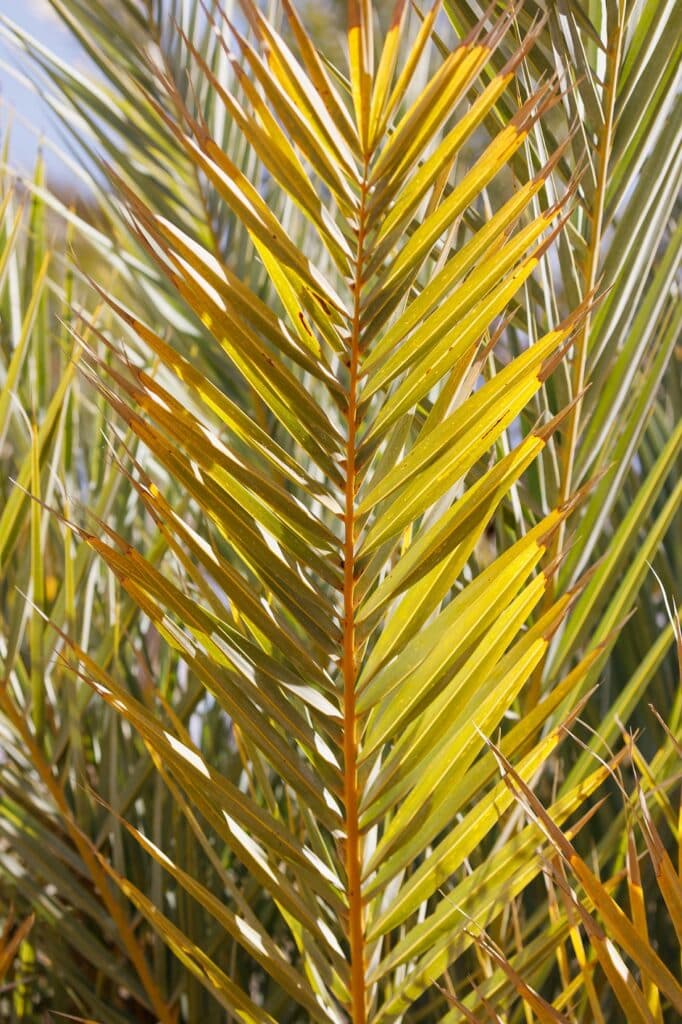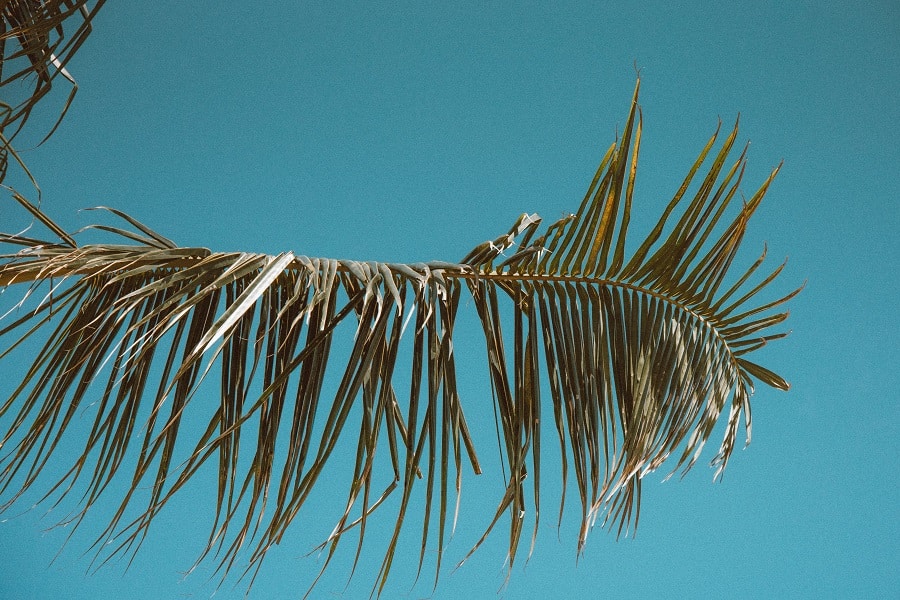Rescue your palm tree turning brown with our expert guide. Unlock the secrets to lush, green fronds and wave goodbye to the stress of brown leaves. Transform your palm into a vibrant oasis with our actionable tips for a thriving, tropical paradise at home.
Have you noticed that your once vibrant and lush palm tree is now starting to turn brown? It can be quite disheartening to see the leaves losing their bright green color and transforming into a dull and lifeless shade. But fear not! In this article, we will explore the various reasons behind why your palm tree may be experiencing this unfortunate change, and provide you with some helpful tips on how to address and prevent further browning. So, let’s get to the root of the issue and revive your palm tree back to its glory!
Understanding the Growth Cycle of Palm Trees
The structure of palm trees
Palm trees are unique in their structure, with a single upright trunk from which their fronds grow. The trunk of a palm tree is covered with a layer of bark that protects it and helps in its growth. At the top of the trunk is the crown, which is made up of the fronds and the apical meristem—a vital part of the tree responsible for its growth and development.

Typical growth pattern of palm trees
Palm trees have a distinct growth pattern that consists of different stages. In the initial stage, palm trees develop a root system that anchors them in the soil and enables them to absorb water and nutrients. Once the root system is established, the tree starts to grow its trunk, adding new layers each year. As the trunk grows taller, new fronds emerge from the apical meristem at the top. This cycle continues throughout the life of the palm tree, with older fronds eventually drooping and being replaced by new ones.
How to identify abnormalities in growth patterns
Understanding the typical growth pattern of palm trees is crucial in identifying any abnormalities. If you notice stunted growth, a lack of new fronds, or an uneven distribution of fronds, it may be a sign that your palm tree is experiencing growth issues. Additionally, if the trunk becomes discolored or cracked, it could indicate a problem with the tree’s growth. Paying close attention to the growth patterns of your palm tree will help you address any issues promptly and ensure its overall health.
Common Reasons for Palm Trees Turning Brown
Improper watering practices
One of the most common reasons for palm trees turning brown is improper watering practices. Overwatering or underwatering can both lead to stress and ultimately cause the fronds to turn brown. It is important to find the right balance in watering, allowing the soil to dry out between waterings but ensuring the palm tree receives adequate moisture.
Lack of essential nutrients
Palm trees require specific nutrients for healthy growth. If a palm tree does not receive enough of these essential nutrients, it can result in nutrient deficiencies, causing the fronds to turn brown. Regularly applying a balanced fertilizer specifically formulated for palm trees can help prevent nutrient deficiencies.
Pests and diseases
Pests and diseases can also cause palm trees to turn brown. Common pests that target palm trees include spider mites, mealybugs, and palm weevils. These pests feed on the tree’s tissues, weakening it and leading to browning. Additionally, diseases such as Fusarium wilt and Ganoderma can cause significant damage to palm trees. Regular inspection and prompt treatment are essential in preventing and controlling these issues.
Unsuitable temperature conditions
Palm trees are generally adapted to thrive in specific temperature ranges. Exposing them to extreme heat or cold can result in browning and damage to the fronds. It is important to choose palm tree species that are suitable for your region’s climate and take measures to protect them from temperature extremes.
Over pruning or trimming
Improper pruning or trimming practices can also contribute to palm trees turning brown. Over pruning, especially the removal of green fronds, can weaken the tree and hinder its ability to photosynthesize, leading to browning. It is important to follow proper pruning techniques and avoid excessive trimming to ensure the tree’s health.
Role of Watering in Palm Tree Health
How improper watering affects palm trees
Water plays a crucial role in the health of palm trees. Improper watering, either overwatering or underwatering, can have detrimental effects on their overall well-being. Overwatering can lead to root rot, where the roots become waterlogged and unable to absorb oxygen. This can result in nutrient deficiencies and cause the fronds to turn brown. On the other hand, underwatering can lead to drought stress, causing the tree to conserve water by turning its fronds brown.

Correct frequency and amount of watering for palm trees
To ensure optimal palm tree health, it is important to find the correct balance in watering. The frequency and amount of watering will depend on factors such as the climate, soil type, and the specific palm tree species. Generally, it is recommended to water palm trees deeply but infrequently, allowing the soil to dry out before the next watering. This encourages the development of a strong root system and prevents the risk of overwatering.
Effects of too much or too little water
Overwatering or underwatering can both have negative effects on palm trees. If a palm tree receives too much water, it can lead to root rot and suffocation of the roots, ultimately causing browning of the fronds. Conversely, underwatering can result in drought stress, causing the tree to conserve water and turn its fronds brown. Finding the right balance in watering is essential to maintain the health and vitality of palm trees.
Symptoms of water-related stress in palm trees
Water-related stress in palm trees can manifest in several ways. Overwatering may cause the fronds to turn yellow or brown, and the appearance of mushrooms or a foul odor around the base of the tree can indicate root rot. Underwatering can cause the fronds to turn brown and crisp, and the soil may become excessively dry. Regularly monitoring the moisture levels of the soil and observing any changes in the appearance of the fronds can help identify water-related stress in palm trees.
Effect of Nutrient Deficiency on Palm Trees
Key nutrients for palm tree health and growth
Palm trees require specific nutrients for healthy growth and development. Some key nutrients essential for palm tree health include nitrogen, potassium, magnesium, and manganese. Nitrogen is important for overall growth and the development of vibrant green fronds. Potassium helps with root development and improves the tree’s resistance to diseases and pests. Magnesium and manganese are crucial for chlorophyll production and play a role in photosynthesis.
Symptoms of nutrient deficiencies
A deficiency in any of these essential nutrients can lead to browning of the fronds and overall tree decline. Nitrogen deficiency may cause yellowing of the fronds, starting with the lower leaves. Potassium deficiency can result in necrotic leaf margins or the appearance of brown stripes on the fronds. Magnesium deficiency may cause yellowing or interveinal chlorosis, where the areas between the leaf veins turn yellow. Manganese deficiency can lead to speckled or streaked fronds.
How to correct nutrient deficiencies
If you suspect nutrient deficiencies in your palm tree, it is important to address them promptly. Applying a balanced palm tree fertilizer according to the manufacturer’s instructions can help correct nutrient deficiencies. Additionally, soil tests can provide valuable information about the nutrient levels in the soil, allowing you to adjust fertilizer applications accordingly. Regularly monitoring the appearance of the fronds and addressing any nutrient deficiencies can help maintain the health and vitality of palm trees.
Diseases and Pests that Cause Browning in Palm Trees
Common diseases affecting palm trees
Palm trees are susceptible to several diseases that can cause browning of the fronds. Fusarium wilt is a fungal disease that affects the vascular system of the tree, causing wilting and browning of fronds from the bottom up. Ganoderma butt rot is another serious disease that causes the trunk to rot from the inside, eventually leading to fronds turning brown and the tree collapsing. Other diseases that can affect palm trees include lethal yellowing, diamond scale, and bud rots.

Pests that target palm trees
Palm trees face threats from various pests that can cause browning and damage. Spider mites are common pests that feed on the tree’s tissues, leading to discoloration and browning of the fronds. Mealybugs are another pest that can infest palm trees, causing honeydew secretion and the appearance of sooty mold. Palm weevils are particularly destructive, burrowing into the trunks and causing severe damage. Other pests include palm aphids, scales, and caterpillars.
Symptoms of disease and pest infestation
Diseases and pests infestations can have visible symptoms on palm trees. Browning and wilting of fronds, starting from the bottom, can indicate fungal diseases like Fusarium wilt. Ganoderma butt rot may cause the trunk to have conks or mushroom-like growths, and the fronds may turn brown and droop. Spider mites and mealybugs can cause yellowing and curling of the fronds, and the presence of webbing or white cottony clusters can indicate their presence. Palm weevil infestations may result in holes or tunnels in the trunk and significant frond damage.
Treatment options for diseases and pests
Treating diseases and pests affecting palm trees requires a combination of preventive measures and targeted treatments. Removing and destroying infected fronds and trunks can help prevent the spread of diseases. Fungicides may be necessary for certain fungal diseases, while insecticides can help control pest populations. It is important to consult with a professional arborist or horticulturist to accurately diagnose the problem and determine the most effective treatment options for diseases and pests.
Impact of Temperature on Palm Tree Health
Ideal temperature range for palm trees
Palm trees thrive in specific temperature ranges, and exposure to unsuitable temperatures can lead to browning and damage. Most palm tree species prefer temperatures around 70°F to 90°F (21°C to 32°C) during the day and around 50°F to 60°F (10°C to 15°C) at night. However, specific palm tree species may have different temperature preferences, so it is important to choose varieties suitable for your region’s climate.
Effects of temperature fluctuations on palm trees
Extreme temperature fluctuations can impact the health of palm trees. Sudden cold snaps or frosts can cause browning and damage to the fronds, especially in more tropical species. High temperatures, especially in combination with drought conditions, can lead to wilted and brown fronds. It is important to monitor weather conditions and take preventive measures, such as covering the tree during frosts or providing shade during heatwaves, to protect palm trees from extreme temperature fluctuations.
How to protect palm trees from harsh temperature conditions
To protect palm trees from harsh temperature conditions, there are several steps you can take. During cold weather, covering the tree with blankets or burlap can provide insulation and prevent frost damage. Applying mulch around the base of the tree helps regulate soil temperature and retain moisture. Providing shade during hot periods can help prevent excessive water loss and sunburn on the fronds. Choosing palm tree species that are well-adapted to your region’s temperature ranges is also crucial in ensuring their long-term health.
Pruning and Trimming Practices for Palm Trees
Importance of proper pruning
Proper pruning is essential for maintaining the health and appearance of palm trees. Pruning removes dead or dying fronds, improves air circulation within the crown, and reduces the risk of pests and diseases. Regularly pruning your palm tree helps promote new frond growth and keeps the tree looking tidy and attractive. It also allows for better exposure to sunlight, which is vital for the tree’s overall health.

Dangers of over-pruning
While pruning is necessary, over-pruning can be detrimental to palm tree health. Removing too many green fronds can disrupt the tree’s ability to photosynthesize and produce energy. This can lead to nutrient deficiencies and browning of the fronds. Over-pruning can also make the tree more susceptible to pests and diseases. It is important to follow proper pruning techniques and avoid excessive removal of green fronds.
Correct techniques for pruning and trimming palm trees
When pruning or trimming palm trees, it is important to follow correct techniques to ensure the tree’s health. Start by removing any dead or dying fronds, carefully cutting close to the trunk. Avoid removing healthy green fronds unless necessary. Prune as close to the trunk as possible, without damaging the bark. It is important to use clean and sharp pruning tools to minimize the risk of disease transmission. If you are unsure about the proper pruning techniques, consider consulting a professional arborist for guidance.
Reversing Browning in Palm Trees
Techniques to nurse a palm tree back to health
If you notice your palm tree turning brown, there are several techniques you can try to help nurse it back to health. Start by addressing any underlying issues, such as improper watering, nutrient deficiencies, or pest infestations. Adjust the watering schedule to ensure the tree receives enough moisture without becoming waterlogged. Apply a balanced palm tree fertilizer to correct any nutrient deficiencies. Treat any pests or diseases affecting the tree with appropriate measures. Additionally, ensure the palm tree is planted in suitable soil and receives adequate sunlight for optimal recovery.
Long-term care for a recovering palm tree
Recovering a palm tree from browning requires long-term care and maintenance. Continue to monitor the watering schedule, ensuring the tree receives appropriate moisture without overwatering. Regularly apply fertilizer formulated for palm trees to maintain proper nutrient levels. Monitor the tree for any signs of pests or diseases and take prompt action if necessary. Prune the tree regularly to remove dead or dying fronds and improve air circulation. Providing ongoing care and monitoring for signs of stress will help the palm tree fully recover and regain its healthy appearance.
When to call for professional help
In some cases, reversing browning in palm trees may require professional assistance. If you have tried various techniques but the palm tree continues to decline or show no signs of improvement, it may be time to seek professional help. Arborists or horticulturists with experience in palm tree care can accurately diagnose the problem and provide appropriate treatment options. They can also conduct soil tests and make specific recommendations based on the unique needs of your palm tree. Seeking professional help ensures that your palm tree receives the best care possible for a full recovery.
Preventative Measures for Palm Tree Health
Regular maintenance and care for palm trees
Regular maintenance and care are essential for preserving the health and vitality of palm trees. This includes proper watering, fertilization, and pruning practices. Regularly inspect the tree for any signs of pests, diseases, or nutrient deficiencies. It is also important to provide adequate protection from extreme temperature conditions and ensure the tree is planted in suitable soil.

Monitoring for early signs of damage or disease
Monitoring palm trees for early signs of damage or disease is crucial in preventing extensive browning or decline. Regularly inspect the fronds for any discoloration or wilting, especially starting from the bottom. Look for signs of pest infestations, such as webbing or white cottony clusters. Check the trunk for any cracks, conks, or holes. Early detection and intervention can help address issues before they become severe and protect the overall health of the palm tree.
Using quality soils and fertilizers
Using quality soils and fertilizers specifically formulated for palm trees is important in ensuring their health. Palm trees thrive in well-draining soils that provide adequate aeration and prevent waterlogging. When planting or repotting a palm tree, choose high-quality soil mixes designed for palms. Additionally, using a balanced palm tree fertilizer according to the manufacturer’s instructions helps provide the necessary nutrients for healthy growth. Quality soils and fertilizers contribute to the overall health and vitality of palm trees.
Nutrient Supplements for Palm Trees
Types of supplements available
Nutrient supplements can provide additional support for palm tree health and growth. There are various types of supplements available, including liquid fertilizers, slow-release pellets, and micronutrient sprays. Liquid fertilizers are typically mixed with water and applied directly to the soil or sprayed onto the fronds. Slow-release pellets are designed to gradually release nutrients over time, reducing the frequency of applications. Micronutrient sprays are used to address specific nutrient deficiencies where targeted supplementation is necessary.
How to use nutrient supplements
When using nutrient supplements for palm trees, it is important to follow the manufacturer’s instructions and guidelines. This includes the recommended application rates, frequency, and method of application. It is typically advisable to apply supplements during the growing season when the palm tree is actively taking up nutrients. Applying supplements to the soil around the tree’s root zone or directly to the fronds can provide the necessary nutrients for healthy growth.
Potential risks and precautions when using supplements
While nutrient supplements can be beneficial for palm tree health, there are some potential risks and precautions to consider. Overapplication of supplements can lead to nutrient imbalances, causing toxicity or nutrient deficiencies. It is important to carefully read and follow the instructions on the product packaging. Additionally, supplements should not be used as a substitute for proper watering, fertilization, and overall care. They should be used in conjunction with a comprehensive maintenance plan for optimal palm tree health. Regular monitoring and observation of the tree’s response to supplements can help ensure their effectiveness and prevent any negative effects.
Conclusion
By understanding the growth cycle of palm trees, common reasons for browning, the role of watering and nutrients, diseases and pests, temperature impact, pruning practices, and preventative measures, you can ensure the health and vitality of your palm trees. By providing proper care and addressing any issues promptly, you can enjoy beautiful, vibrant palm trees for years to come.




